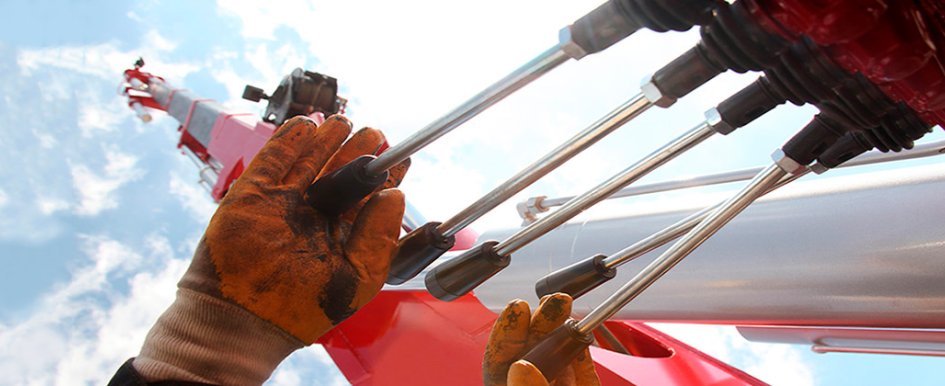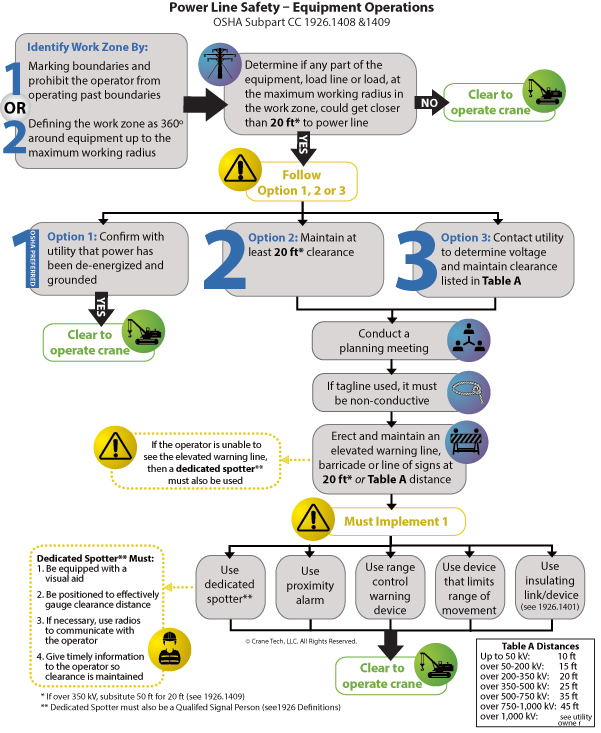
It’s a well-known fact that power lines and cranes do not mix. Between 1992 and 2006, 102 construction workers died as a result of crane-related, overhead power line electrocutions. To help reduce these needless deaths, in 2010, OSHA spelled out the steps necessary for cranes to work around power lines in the updated Cranes and Derricks in Construction Standard OSHA 1926 Subpart CC. While these regulations have helped, there were five fatalities directly related to cranes contacting overhead power lines in 2015. This is a sign that more education needs to take place regarding equipment working near power lines. So what does it take to work safely around power lines?
- Employers who operate cranes on a construction site are responsible for complying with clearance distances and training aspects of OSHA 1926 Subpart CC, Sections 1407-1411.
- Other employers not directly involved with crane operations, but whose personnel work at the site, also have training responsibilities to protect employees against hazards related to crane operations, according to OSHA 1926.1408 (g).
Distance Requirements
One of the most significant changes OSHA made in 1926 Subpart CC was to increase the basic minimum approach distance/clearance for energized overhead power lines from 10 feet to 20 feet (for up to 350kV lines) and 50 feet (for over 350kV lines). This does not mean that equipment cannot work closer than the 20- or 50-foot distance. However, it does mean that if the equipment needs to work closer to energized lines, designated safety measures must be followed.
Safety Measures
Before beginning crane operations the employer must identify the work zone. This requirement is satisfied by the employer performing one of the following:
- Identify the work zone by demarcating boundaries and prohibiting the operator from operating the crane past those boundaries.
- Define the work zone as the area 360 degrees around the crane, up to the crane’s maximum working radius.
Then, the employer must determine if any part of the crane, load line or load could get closer than 20 feet to a power line if the crane is operated at its maximum working radius within the work zone. Then, the employer must determine if any part of the crane, load line or load could get closer than 20 feet to a power line if the crane is operated at its maximum working radius within the work zone. If the crane is within the 20-foot clearance, it requires one of three options to be satisfied before work can start. These options and their requirements are detailed in OSHA Subpart CC 1926.1408 and are highlighted in Figure 1.

One key point to understand is that OSHA prefers Option 1: ‘De-energize and ground method’ to protect against electrocution and avoid the need for other precautions. However, there are instances where de-energizing is not practical. When this is the case, OSHA outlined two other options and the actions required to safeguard workers, equipment and electric consumers. Both Option 2 and Option 3 require that all parts of the crane remain a specified distance away from the energized power line. Option 2 states if the voltage of the energized power line is unknown, then a 20-foot clearance must be used (for up to 350kV lines). Option 3 allows work closer to an energized power line only if the specific line voltage is known—the approved distance is listed on Table A. After the appropriate clearance is determined, all of the required safety measures must be met before work can proceed.
Training Requirements
There is still another piece of the puzzle—training, as outlined in 1926.1408.g—which is required before crane work begins. This applies to all employers with personnel working in the near vicinity—regardless if they are directly involved with crane operations or not. Workers need to understand how electricity dissipates across the ground and the procedures to follow in the event of electrical contact with the power line.
How Electrical Current Travels
It is important to know that when any part of the crane, load line or load contacts energized power, the crane will become electrically energized and so will the ground around the crane. The electrical current/voltage in the ground will not be consistent as it disperses throughout the site—some areas will have a higher voltage and others a lower voltage (called ground potentials). The difference between one voltage and the next can be fatal, as the body cannot handle more than one voltage passing through it. In general, the crane operator will be safe as long as they remain on the crane, as the crane will have a consistent voltage passing through it. The greatest danger is faced by a person who is in contact with the crane/load and ground, as these typically have different voltages passing through them. Also, personnel who are near but not touching the crane or load can suffer electric shock if they inadvertently move or come in contact with more than one voltage. In fact, many times workers may not be impacted at the time of power line contact, but how they react can make the difference between life and death. It is human nature to rush to the aid of someone who appears injured, but if personnel move and enter an energized area, they may be exposed to invisible and unknown voltage levels under their feet and they place themselves at substantial risk for serious injury or death. Training must reinforce the dangers, and workers around mobile crane activities must be educated to look up first. The electricity flowing through the crane and surrounding site will be invisible and generally silent. There may be a slight buzz or a flash of light, but the only sign of contact may be to look up and see it. There may be no other indication that the crane/area has been electrically charged.
What to Do If There is Electrical Contact
If any part of the crane, load line or load contacts energized power, it is key to have these procedures be of second nature to all personnel on the site:
- Do not move—Warn everyone in the vicinity of the crane to keep their feet planted and stay exactly where they are until clearance is given by the utility or contact with the power line no longer exists. Remember, if they are standing, then they need to continue to stand in the exact spot to stay alive.
- Do not touch the load—Keep everyone away from the load and its immediate area. It could be electrified and dangerous. This is why nonconductive taglines should be used.
- Do not touch equipment—Keep everyone away from machinery, equipment or material in the immediate area. It could be electrified and dangerous.
- Do not touch the personnel—Do not touch any person who is in the vicinity of the crane.
- Call 911—Have a person who is in a safe area call 911 to have the fire department contact the utility to de-energize the line. Remember, just because the power may appear to be turned off, there may be an auto reset that could re-energize the power in the line.
- Break contact with the line—If possible, the operator should break the contact with the power line. They should do the opposite action that caused the power line contact. Since the power line may have welded itself to the crane or load on contact, it may mean that the power line will snap when the contact is broken. Provide plenty of clearance for the crane. Watch for broken lines that may be energized.
- Seek medical care—Once it has been confirmed that the area is de-energized and safe, make sure proper medical treatment is administered.
Last Resorts
The next few items are the actions to take when personnel believe his/her life is in danger and they must clear the area:
- Shuffle feet—If personnel must move, move carefully away from the area, shuffling feet close together to keep both feet in contact with the ground. This reduces the likelihood of ending up in contact with different voltages in the ground. How far to shuffle away is the difficult part because there is no way to tell how far the ground is energized. Do not make contact with any object while shuffling away.
- Jump away—If personnel must evacuate equipment, then jump away from it. Landing with both feet together, make sure not to touch the ground with hands or touch any part of the equipment at the same time. This can be a very risky maneuver as one attempts to jump from an elevated crane deck several feet without stumbling, falling over or reaching out to steady oneself.
Personnel are only clear to move once the electrical contact is broken or the area has been deemed safe by the utility company and/or first responders. Remember, the first line of defense is to follow the OSHA 1926 Subpart CC standards to safeguard workers from the danger of electrical contact. This is where training and education can make the difference between life and death. Proactively review the power line safety chart at every site (shown in Figure 1), follow the OSHA regulations to ensure compliance and teach the procedures to employees. They will thank you for it.
Beyond Cranes
The power line safety regulations in OSHA 1926.1407-1411 are specific to crane operations. However, power line contact is no less dangerous to other types of equipment. In 2015, there were 11 fatalities related to construction equipment coming in direct contact with power lines. While these machines are excluded from the minimum clearance distance requirements, the impact of contact is no less fatal. Use special care and concern when operating any type of equipment around power lines—the lives of your personnel depend on it.
Tip:
Before working near power lines, it is a good idea to give a courtesy call to the local fire department for the area. Give them a heads up that you will have cranes working in proximity to power lines. Let them know you will be working within OSHA’s guidelines. Ask if they have a particular number for de-energizing lines to call in case of a power line contact (besides 911). Having this number readily available on-site should lessen response times, too.
